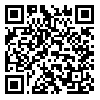Sat, Jan 3, 2026
| فارسی
Volume 9, Issue 1 (Spring 2007)
Advances in Cognitive Sciences 2007, 9(1): 33-39 |
Back to browse issues page
Download citation:
BibTeX | RIS | EndNote | Medlars | ProCite | Reference Manager | RefWorks
Send citation to:



BibTeX | RIS | EndNote | Medlars | ProCite | Reference Manager | RefWorks
Send citation to:
Nejati V, Ashayeri H, Garousi Farshi M, Aghdasi M T. Dual Task Interference in Explicit and Implicit Sequence Learning in Youth and Elderly. Advances in Cognitive Sciences 2007; 9 (1) :33-39
URL: http://icssjournal.ir/article-1-336-en.html
URL: http://icssjournal.ir/article-1-336-en.html
1- Tabriz University, Tabriz, Iran.
Abstract: (3415 Views)
Objective: The aim of this study was to compare the attentional demand in implicit and explicit learning in the youth and elderly.
Method: First, the software for presenting sequential stimuli and the registration of time and error and the presentation of odd ball task was designed. This software registered the response time to sequential stimuli as well as the number of errors. In this study one group of elderly subjects and one group of young subjects participated in two situations of implicit and explicit learning (four groups of 15 subjects each). Multivariate analysis of variance was used to analyze data. The effects of age, learning situation (implicit and explicit), and type of stimulus (with a regular or irregular sequence) on lowering the reaction time and the reduction in the number of errors were evaluated.
Results: The youth showed fewer errors in response, shorter response time, and a higher efficiency in the second task. The error in response was less prequent in implicit learning of both age groups. With regular sequences these were fewer errors in response, less response time, and higher efficiency in the second task than with the irregular sequences.
Conclusion: Dual task interference in implicit learning is lower than in explicit learning. Based on these results, implicit learning has a lower attentional demand than explicit learning. Therefore, in situations of divided attention (especially in the elderly) it is better to make use of implicit learning.
Method: First, the software for presenting sequential stimuli and the registration of time and error and the presentation of odd ball task was designed. This software registered the response time to sequential stimuli as well as the number of errors. In this study one group of elderly subjects and one group of young subjects participated in two situations of implicit and explicit learning (four groups of 15 subjects each). Multivariate analysis of variance was used to analyze data. The effects of age, learning situation (implicit and explicit), and type of stimulus (with a regular or irregular sequence) on lowering the reaction time and the reduction in the number of errors were evaluated.
Results: The youth showed fewer errors in response, shorter response time, and a higher efficiency in the second task. The error in response was less prequent in implicit learning of both age groups. With regular sequences these were fewer errors in response, less response time, and higher efficiency in the second task than with the irregular sequences.
Conclusion: Dual task interference in implicit learning is lower than in explicit learning. Based on these results, implicit learning has a lower attentional demand than explicit learning. Therefore, in situations of divided attention (especially in the elderly) it is better to make use of implicit learning.
Type of Study: Research |
Subject:
Special
Received: 2006/10/23 | Accepted: 2007/01/18 | Published: 2007/03/21
Received: 2006/10/23 | Accepted: 2007/01/18 | Published: 2007/03/21
Send email to the article author
| Rights and permissions | |
 |
This work is licensed under a Creative Commons Attribution-NonCommercial 4.0 International License. |



